Did you know that over 40% of amphibian species are threatened with extinction? This alarming statistic has sparked a growing interest in raising these fascinating creatures in controlled environments. Many enthusiasts are now turning to breeding frogs at home as a way to contribute to conservation efforts while enjoying a unique hobby.
Creating a suitable habitat for frogs involves careful planning. Factors like species selection, water quality, and lifecycle management play a crucial role in their survival. For example, the Oregon spotted frog program at the Greater Vancouver Zoo has shown how proper care can help endangered species thrive.
This guide will walk you through the essentials of setting up a healthy environment for tadpoles and adult frogs. From selecting the right species to maintaining water conditions, you’ll learn how to make a positive impact on amphibian preservation.
Key Takeaways
- Home frog breeding is a rewarding and conservation-focused hobby.
- Species selection and habitat setup are critical for success.
- Proper care contributes to amphibian preservation efforts.
- Water quality is essential for tadpoles and adult frogs.
- Programs like the Oregon spotted frog initiative highlight the importance of breeding.
Introduction to Breeding Frogs at Home
Frog reproduction is a fascinating process that requires careful attention to environmental details. These creatures rely heavily on specific conditions to thrive, making habitat replication essential. For example, the Oregon spotted frog program demonstrates how precise timing and communal egg-laying behaviors contribute to successful conservation efforts.
The breeding process involves several stages. It begins with courtship calls, where males attract females. This is followed by amplexus, a unique mating behavior where the male clasps the female to fertilize eggs externally. After egg-laying, the eggs develop into tadpoles, which eventually undergo metamorphosis into adult frogs.
Maintaining the right conditions is crucial. Water temperatures between 80-85°F are ideal for egg development. Without these specific parameters, the eggs may not hatch successfully. This highlights the importance of research and preparation before starting a project.
Understanding the unique biology of these creatures is key. Each species has its own environmental dependencies, making habitat specificity a top priority. By replicating natural conditions, enthusiasts can contribute to conservation while enjoying this rewarding hobby.
Choosing the Right Frog Species for Breeding
Selecting the right species is the first step to success. Not all species are suitable for beginners, and each has unique needs. Understanding these differences ensures a thriving habitat and a rewarding experience.
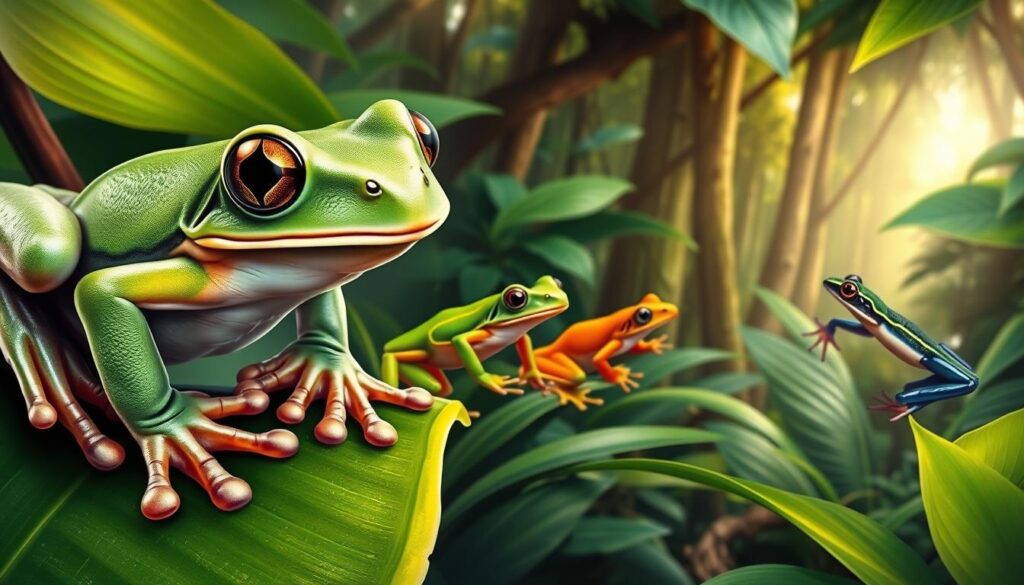
Popular Frog Species for Beginners
For those new to the hobby, fire-bellied toads and White’s tree frogs are excellent choices. Fire-bellied toads are hardy and adapt well to room temperatures (68-75°F). White’s tree frogs are known for their calm demeanor and ease of care.
On the other hand, Pacman frogs require more expertise. They need spacious tanks (30+ gallons) and specific conditions to thrive. These species are better suited for experienced enthusiasts.
Factors to Consider When Choosing Frogs
Several factors should guide your decision:
- Temperature Needs: Fire-bellied toads thrive at room temperature, while others may require precise heating.
- Space Requirements: Pacman frogs need larger tanks, making them less ideal for small setups.
- Dietary Considerations: Most species, like White’s tree frogs, thrive on a diet of crickets. Pacman frogs may need supplements like pinkie mice.
- Legal Considerations: Ensure the species you choose is not protected or restricted. Opt for captive-bred alternatives when possible.
By considering these factors, you can create a suitable environment for your chosen species and enjoy a successful project.
Setting Up the Perfect Breeding Environment
Creating the ideal environment for these creatures starts with the right setup. A well-planned habitat ensures their health and supports their natural behaviors. From the size of the tank to the quality of the water, every detail matters.
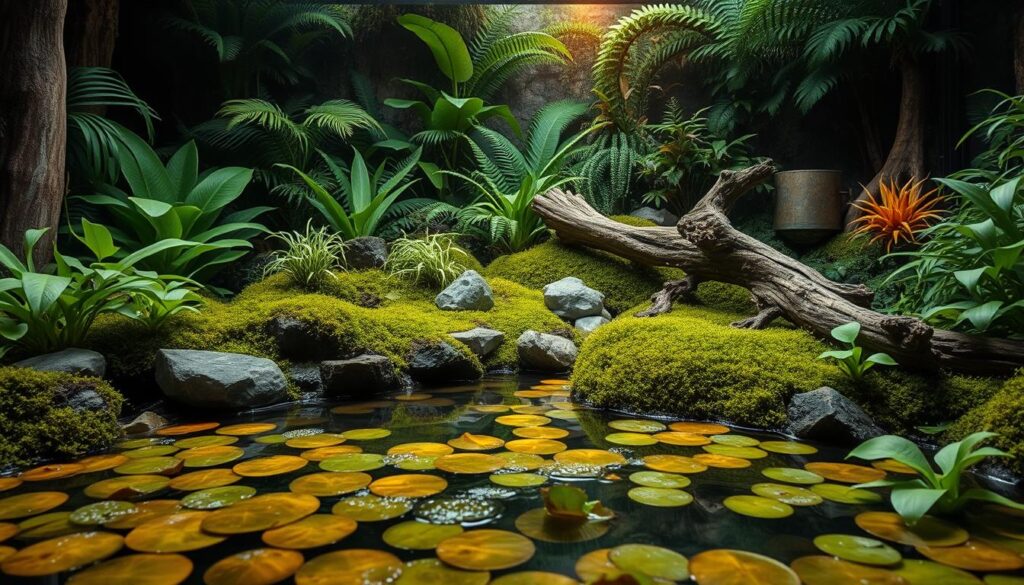
Tank Setup and Equipment
The size of the tank is crucial. For two adult frogs, a minimum of 30 gallons is recommended. Add 10 gallons for each additional frog. Larger tanks provide more space and better stability for water conditions.
Filtration systems are essential for maintaining water quality. Sponge filters are ideal for tadpoles, while canister filters work best for adults. Both options help remove toxins and keep the environment clean.
Lighting is another key factor. UV lighting supports their health, while LED grow lights mimic natural sunlight. A submersible heater and digital thermometer ensure the temperature stays within the ideal range of 75-85°F.
Water Quality and Temperature
Maintaining the right water parameters is vital. The pH level should be between 6.5 and 7.5, and ammonia levels must stay below 0.25ppm. Regular testing ensures the environment remains safe and stable.
Substrate options like coconut coir or sphagnum moss help retain moisture. These materials also create a natural feel, making the aquarium more comfortable for its inhabitants.
For more detailed guidance on creating a frog habitat, check out this step-by-step guide. It covers everything from tank setup to maintenance tips.
Understanding Frog Breeding Behavior
Understanding the behavior of these amphibians during their reproductive cycle is key to success. Their actions are driven by instinct and environmental cues, making it essential to replicate natural conditions.
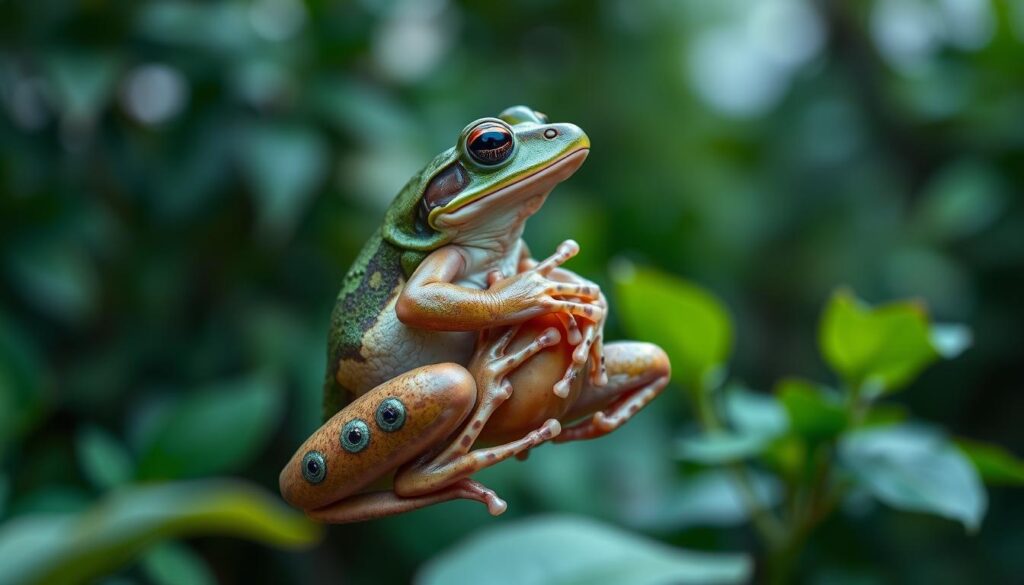
Courtship and Mating Rituals
Mating begins with distinct vocalizations. For example, Oregon spotted males produce a unique “knocking” sound to attract females. These calls are often heard during the breeding season, signaling readiness to mate.
Once a female responds, the male clasps her in a behavior known as amplexus. This position ensures external fertilization as the female releases her eggs. In some species, multiple males may form “mating balls” around a single female, increasing competition.
Egg-Laying and Fertilization
After amplexus, the female deposits her eggs in specific locations. Oregon spotted frogs, for instance, lay 800 to 2,000 eggs in vegetated shallows. Some species attach eggs to submerged plants, while others create surface rafts.
Parental care varies widely. Most species provide no care after egg-laying, leaving the eggs to develop independently. Environmental factors like seasonal rainfall and temperature fluctuations play a crucial role in triggering these behaviors.
Creating a Rain Chamber for Breeding
A well-designed rain chamber mimics natural conditions for amphibians. It provides the right humidity and water flow, essential for their health and reproduction. Whether you choose a complex bioactive system or a budget-friendly setup, the key is to replicate their natural habitat.
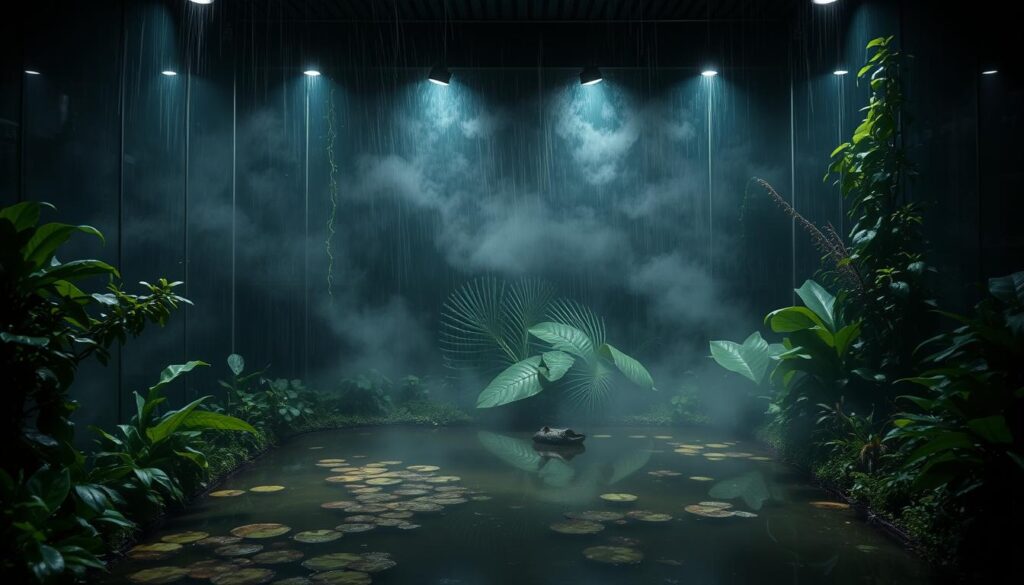
DIY Rain Chamber Setup
There are two effective designs to consider: a 150-gallon planted vivarium and a 40-gallon basic setup with a spray bar. Both have their advantages, depending on your goals and resources.
| Feature | 150-Gallon Planted Vivarium | 40-Gallon Basic Setup |
|---|---|---|
| Complexity | High | Low |
| Cost | Expensive | Budget-friendly |
| Maintenance | Moderate | Easy |
| Humidity Control | Excellent | Good |
Essential components include a submersible pump, misting nozzles, and drainage layers. For the basic setup, a PVC pipe spray rig is a cost-effective option. Ensure the chamber cycles for two weeks to allow mineral buildup before introducing amphibians.
Maintaining the Rain Chamber
Regular maintenance is crucial for a healthy environment. Daily pH checks and weekly filter changes are recommended. Managing biofilm and ensuring proper drainage will prevent issues.
“Using aged spring water with Miner-All supplements can significantly improve tadpole health.”
For more tips on maintaining humidity and creating a suitable environment, check out this complete guide. It covers everything from substrate choices to misting schedules.
Caring for Frog Eggs and Tadpoles
Proper care during the early stages of amphibian development ensures healthy growth and survival. From monitoring eggs to raising tadpoles, each step requires attention to detail and the right conditions. This section provides essential tips for success.
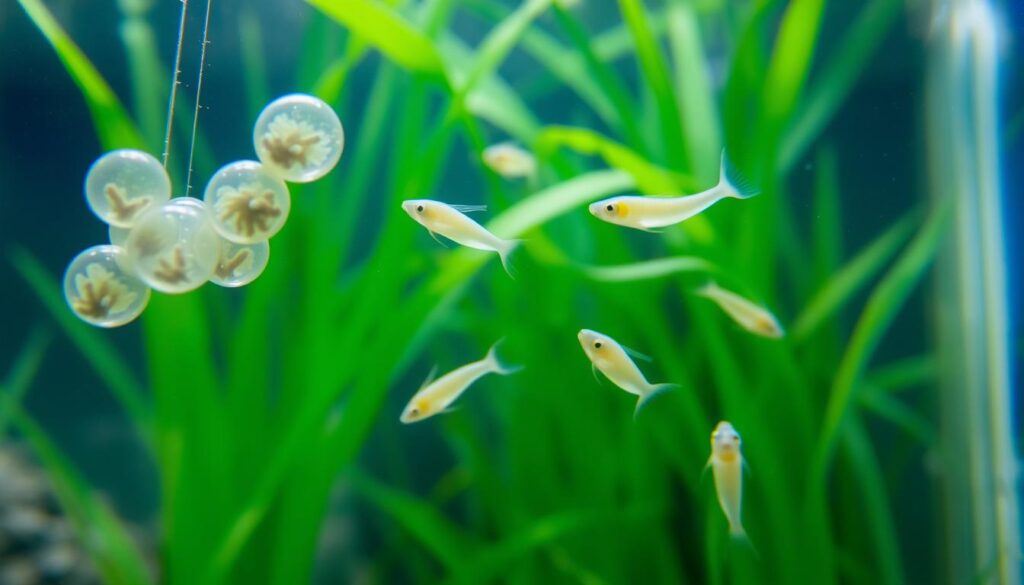
Egg Care and Hatching
Monitoring eggs is crucial for successful hatching. Fungus can be a common issue, but treatments like methylene blue help prevent contamination. Regularly inspect egg masses to ensure they remain healthy.
Maintaining the right water temperature is key. Tropical species thrive at 82-85°F, while temperate species prefer 68-72°F. For example, White’s tree frog eggs hatch in just two days under optimal conditions.
Raising Healthy Tadpoles
Once hatched, tadpoles need a balanced diet and clean water. Feed them three times daily with nutrient-rich options like tubifex worms or crushed fish flakes. Live microworms are another excellent choice for promoting growth.
When transferring tadpoles to a new tank, acclimate them over 20 minutes to avoid shock. Overcrowding can lead to stress and poor health, so limit the number to 10 per gallon with a strong filter to maintain water quality.
| Food Type | Frequency | Benefits |
|---|---|---|
| Crushed Fish Flakes | 3x Daily | Easy to digest, cost-effective |
| Live Microworms | 3x Daily | High protein, promotes growth |
| Tubifex Worms | 3x Daily | Nutrient-rich, supports health |
By following these guidelines, you can ensure your tadpoles develop into healthy adults, ready for the next stage of metamorphosis.
Transitioning Tadpoles to Adult Frogs
Watching tadpoles transform into adults is a rewarding experience for enthusiasts. This stage, known as metamorphosis, involves significant physical and behavioral changes. Proper care during this phase ensures healthy development and a smooth transition to adulthood.
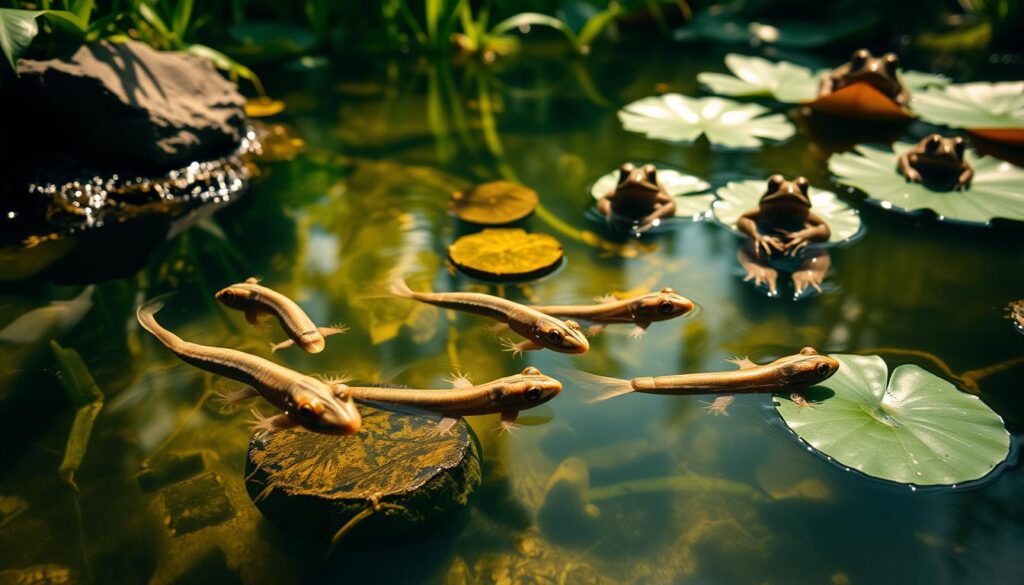
Metamorphosis Process
The first signs of metamorphosis include the emergence of front legs and the gradual absorption of the tail. At this stage, tadpoles are often referred to as froglets. Their diet shifts from plant-based to carnivorous, requiring nutrient-rich foods like pinhead crickets dusted with calcium and D3.
Creating a terrestrial transition area is essential. Floating cork bark platforms or shallow water dishes provide a safe space for froglets to crawl out of the water. This mimics their natural habitat and supports their development.
Setting Up the Adult Frog Habitat
Once fully transformed, froglets need a suitable environment to thrive. A 10-gallon tank setup with shallow water dishes and play sand substrate is ideal. Adding mineral supplements ensures they receive essential nutrients.
UV lighting is crucial for their health. A 12-hour light cycle mimics natural sunlight and supports their growth. Maintaining proper humidity levels is equally important, as it prevents dehydration and promotes overall well-being.
| Stage | Key Requirements |
|---|---|
| Metamorphosis | Terrestrial transition areas, nutrient-rich diet |
| Juvenile Enclosure | 10-gallon tank, UV lighting, shallow water dishes |
| Adult Habitat | Play sand substrate, mineral supplements, humidity control |
“Proper care during metamorphosis ensures healthy development and a smooth transition to adulthood.”
For more detailed guidance on raising tadpoles, check out this step-by-step guide. It covers everything from feeding to habitat setup, ensuring your amphibians thrive at every stage.
Common Challenges in Breeding Frogs at Home
Raising amphibians in a controlled environment comes with its own set of challenges. From maintaining optimal conditions to preventing diseases, enthusiasts must stay vigilant to ensure their health and well-being. Addressing these issues effectively can make the difference between success and failure.
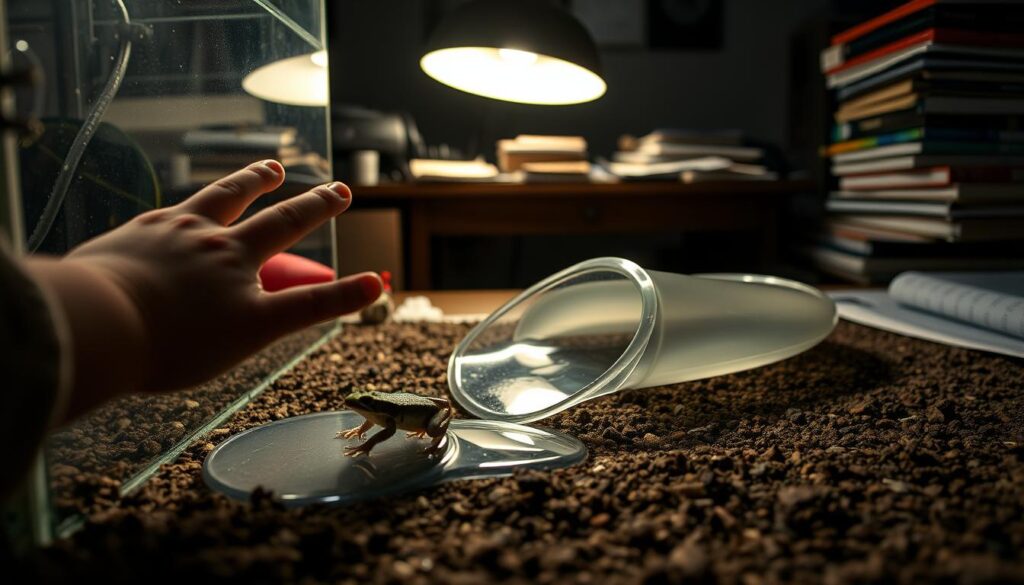
Preventing and Treating Diseases
One of the most significant challenges is managing diseases. Amphibians are particularly susceptible to infections like Chytrid fungus, which can be fatal if untreated. Symptoms include lethargy, skin discoloration, and loss of appetite. Early diagnosis and treatment are crucial to prevent outbreaks.
Another common issue is metabolic bone disease, often caused by insufficient calcium or UVB exposure. Providing calcium supplements and ensuring proper lighting can help prevent this condition. For more tips on maintaining a healthy environment, check out this resource.
Maintaining Optimal Conditions
Keeping the right temperature and water quality is essential. Sudden changes can stress amphibians, leading to health problems. Regularly test water parameters like pH and ammonia levels to ensure a stable environment.
Strict quarantine practices are also vital. Introducing new animals without isolating them first can spread pathogens. A 30-day quarantine period helps prevent contamination and ensures the safety of existing inhabitants.
| Challenge | Solution |
|---|---|
| Chytrid Fungus | Early diagnosis, antifungal treatments |
| Metabolic Bone Disease | Calcium supplements, UVB lighting |
| Water Quality Issues | Regular testing, filtration systems |
| Pathogen Spread | Strict quarantine protocols |
“Preventing diseases and maintaining optimal conditions are key to ensuring the health of your amphibians.”
By addressing these challenges proactively, enthusiasts can create a thriving environment for their amphibians. Regular monitoring and timely interventions are essential for long-term success.
Conclusion
Contributing to amphibian preservation through a controlled environment is both fulfilling and impactful. Understanding species-specific needs, maintaining proper habitat conditions, and managing lifecycles are essential for success. This hobby not only brings personal satisfaction but also supports conservation efforts for endangered species.
Responsible practices, such as avoiding wild-caught specimens and joining breeding networks, ensure ethical and sustainable participation. Enthusiasts can further their impact by connecting with organizations like the Association of Zoos & Aquariums. These groups provide valuable resources and guidance for those interested in breeding programs.
By dedicating time and effort, individuals can make a meaningful difference in amphibian preservation. The journey is rewarding, offering both personal growth and a chance to contribute to a greater cause.
FAQ
What species are best for beginners?
How do I set up a tank for breeding?
What is a rain chamber, and why is it important?
How do I care for frog eggs?
What do tadpoles eat?
How long does it take for tadpoles to become adults?
What are common challenges in breeding frogs?
Can I use tap water for my frogs?
How do I know if my frogs are ready to breed?
What should I feed adult frogs?

I’m Lena Adams—a product of an unconventional upbringing in the African wilderness. My father, a daring explorer of African wildlife, sparked my fascination with reptiles, a passion that intertwined with the tragic loss of my mother during an expedition, leaving an indelible mark on my life. Driven to understand the creatures that captivated my parents, I embarked on my journey, sharing insights about reptiles, frogs, and lizards on my website. Through my explorations and conservation efforts, I honour my family’s legacy while seeking connections—to the creatures, nature, and the mother whose presence I yearn to understand.
